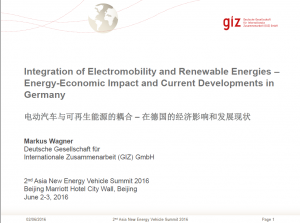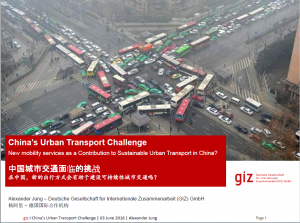 China’s continuous ambitions towards a green transport revolution have shaped the general tenor of a sustainable transport system. Furthermore, financial as well as non-financial incentives have had a notable impact on an expanding green transport network. Despite political efforts, this brought about a rebound in the vehicle-related industry, where the uptake of new energy vehicles has been swift in recent years. However, alternative mobility is still at an embryonic stage and requires further promotional endeavours.
China’s continuous ambitions towards a green transport revolution have shaped the general tenor of a sustainable transport system. Furthermore, financial as well as non-financial incentives have had a notable impact on an expanding green transport network. Despite political efforts, this brought about a rebound in the vehicle-related industry, where the uptake of new energy vehicles has been swift in recent years. However, alternative mobility is still at an embryonic stage and requires further promotional endeavours.
Based on the thematic relevance, this years 2nd two-day conference Asia New Energy Vehicle Summit taking place from June 2-3 in Beijing, brought together experts from the industry and research contributing to a more sustainable transport development. Following a thematic structure each speaker was addressing one of the four key topics, starting with Global Status and Tendency of New Energy Vehicle Industry, giving not only a general outlook for future developments of NEVs, but also presenting recent research results in lightweight technology or intelligent connected vehicles. The second part was then delving deeper into the specifics of lightweight technology and NEV powertrains, while session three was about the integration of OEM and power battery technology. And lastly in session four speakers were discussing how intelligent connected vehicles and inductive charging is promoting e-mobility.
As a longstanding and experienced partner in China’s mobility developments, GIZ China Sustainable Transport Programme was invited to share their research results. Markus Wagner, on behalf of GIZ, was talking about Germany’s experiences with the impact of electromobility and renewable energies on the energy sector. With Germany having renewable energies as their main energy source for electricity production it is essential to foster a smart energy management. Even more so if electric vehicles will increase peak loads and overall energy load. A possible solution would be finding energy management strategies in accordance with the normative vehicle-usage, private as well as commercial. First pilot projects were already implemented to further optimize and control charging behaviour.
Later in session four Alexander Jung, who was responsible for the project Carsharing as Contribution to Sustainable Urban Transport in China, was responding to China’s growing challenges in urban transport and the increasing necessity for an alternative mobility service which can be seen in carsharing. As now, Jung points out, the immediate challenge is to tackle China’s increasing vehicle stock from 120 million in 2015 to 500 million in 2030. This will not only encourage traffic congestion but also cause severe environmental damage. Thus, carsharing can contribute to a less harmful transport system and since its integration in several Chinese cities it’s been well adopted and seems to enfeeble the value of car-ownership. But compared to other mobility trends like ride-hailing services, carsharing is still at an emerging stage.
In conclusion it can be said, that the 2nd Asia New Energy Vehicle Summit was giving a good overview of researcher’s and industry representative’s status quo, knowing that China is not only facing major challenges in the transport sector, but also politically and economically willing to, both, tackle and profit of the situation. Nevertheless, China will need to further deepen the dialogue with the industry and international experts in order to meet their target of a green transport revolution.
For more information on GIZ China’s contribution to the 2nd Asia New Energy Vehicle Summit please see the following two presentations:
 [PPT] Integration of Electromobility and Renewable Energies – Energy-Economic Impact and Current Developments in Germany
[PPT] Integration of Electromobility and Renewable Energies – Energy-Economic Impact and Current Developments in Germany
电动汽车与可再生能源的耦合 – 在德国的经济影响和发展现状(EN/CN)

[PPT] China’s Urban Transport Challenge – New Mobility Services as a Contribution to Sustainable Urban Transport in China?
中国城市交通面临的挑战
在中国,新的出行方式会有助于建设可持续性城市交通吗?(EN/CN)


